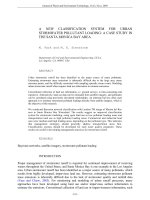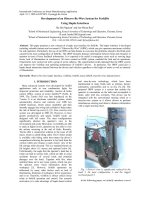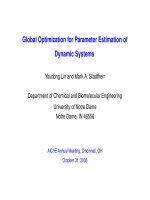GSM Global System for Mobiles
Bạn đang xem bản rút gọn của tài liệu. Xem và tải ngay bản đầy đủ của tài liệu tại đây (2.58 MB, 178 trang )
1
Global System
for Mobiles
GSM
2
TOPICS
• GSM CONCEPTS
• GSM SYSTEM ARCHITECTURE
• IDENTITIES USED IN GSM
• GSM CHANNELS
• GSM RADIO LINK
• MOBILITY MANAGEMENT
• CALL MANAGEMENT
• RADIO RESOURCE MANAGEMENT
3
TOPICS
• GSM CONCEPTS
• GSM SYSTEM ARCHITECTURE
• IDENTITIES USED IN GSM
• GSM CHANNELS
• GSM RADIO LINK
• MOBILITY MANAGEMENT
• CALL MANAGEMENT
• RADIO RESOURCE MANAGEMENT
4
Telecom Basics
• Communication
– Voice and Data
– Analog and Digital
– Circuit Switched and Packet Switched
– Media - Copper Wire, Co-axial cable, Air, Optical
Fibre
– Networks -PSTN, ISDN, PDN and Mobile
Networks
5
Background to GSM
• 1G : Advanced Mobile Phone Service (AMPS)
• Analog, Circuit Switched, FDMA, FDD
• 2G : Digital Advanced Mobile Phone Service (D-AMPS)
• Digital, Circuit Switched, FDMA, FDD
• 2G : Global System for Mobile (GSM)
• Digital, Circuit Switched, FDMA and TDMA, FDD
• 2G : Code Division Multiple Access (CDMA)
• Digital, Circuit Switched, FDMA, SS, FDD
6
GSM History
7
1982: Groupe Spécial Mobile (GSM)
created
1984: Description of GSM features
1985: List of recommendations settled
1987: Initial MoU (Memorandum of
Understanding) aside the drafting
of technical specifications was
signed by network operators of 13
countries:
1988: Validation and trials, of the radio
interface.
1991: First system trials are
demonstrated at the Telecom 91
exhibition.
1992: Official commercial launch of
GSM service in Europe. First
Launch in Finland
1993: The GSM-MoU has 62
signatories in 39 countries
worldwide.
1995: Specifications of GSM phase 2
are frozen.
1999: GSM MoU joins 3GPP (UMTS)
GPRS Trials begins
2000: 480M GSM subscribers
Worldwide
First GPRS Networks roll out
End 2002: 792M GSM subscribers
Worldwide
Development of the GSM Standard
12 SERIES
OPERATION AND
MAINTENANCE
01 SERIES
GENERAL
02 SERIES
SERVICE ASPECTS
03 SERIES
NETWORK ASPECTS
04 SERIES
MS-BSS INTERFACE AND
PROTOCOLS
05 SERIES
PHYSICAL LAYER ON THE
RADIO PATH.
06 SERIES
SPEECH CODING
SPECIFICATIONS
07 SERIES
TERMINAL ADAPTERS
FOR MOBILE STATIONS
11 SERIES
EQUIPMENT AND TYPE
APPROVAL SPECIFICATIONS
10 SERIES
SERVICE INTERWORKING
09 SERIES
NETWORK
INTERWORKING
08 SERIES
BSS TO MSC INTERFACES
GSM Specifications
Increasing GSM Data Rates
Transmission
Time
GPRS = General Packet Radio Service
HSCSD = High Speed Circuit Switched Data
EDGE = Enhanced Data rate for GSM Evolution
UMTS = Universal Mobile Telecommunication System
10 sec 1 min 10 min 1 hour0
UMTS
E/GPRS
ISDN
PSTN
GSM
webe-mail photo
web photo
web photo
video
clip
report
photo
web photo
video
clip
report
video
clip
report
video
clip
report
video
clip
report
10
throughput kbps
10 k
100 k
64 k
1 M
2 M
1 k
1998 1999 2000 2001
2002
Time frame
UMTS
UMTS
GPRS
GPRS
HSCSD
HSCSD
9.6
9.6
14.4
14.4
p
a
c
k
e
t
GPRS = General Packet Radio Service
HSCSD = High Speed Circuit Switched Data
EDGE = Enhanced Data rate for GSM Evolution
UMTS = Universal Mobile Telecommunication System
EDGE
c
i
r
c
ui
t
Wireless Data Technology Options
11
Circuit mode
Packet mode
A
→
FD
→
H
C
→
G
C
→
G
C
→
G
C
→
G
C
→
G
D
→
H
D
→
H
A
→
FD
→
H
D
→
H
A
→
F
A
→
F
A
→
F
A
B
C
D
E
F
G
H
Circuit-Switched or Packet-Switched
12
Multiple Access Technique
• Multiple Access – Achieved by dividing the available
radio frequency spectrum, so that multiple users can
be given access at the same time.
• FDMA - Frequency Division Multiple Access
– ( eg: GSM each Frequency channel is 200KHz)
• TDMA - Time Division Multiple Access
– ( eg: GSM each frequency channel is divided into
8 timeslots)
• CDMA - Code Division Multiple Access
– (eg: IS95- Each User data is coded with a unique
code)
13
Duplex Technique
• Duplex - How the up link and Down link of a user
is separated
• FDD - Frequency Division Duplex
– (eg:In GSM the up link and down link of a user is
separated by 45MHz )
• TDD - Time Division Duplex
– (the up link and down link of a user will be at the same
frequency but at different Time )
14
Cellular
Networking technology
that breaks geographic
area into cells shaped
like honey comb
Cell
is the radio coverage
area of one base
transceiver station
1
2
3
4
5
6
7
6
7
2
1
5
GSM Concepts -
Cellular Structure
15
What are the types in
GSM Network?
• GSM-900 (Channels 125 operating band 900Mhz
carrier spacing 200khz spacing 45Mhz)
• GSM -1800 (Channels 374 spacing 95Mhz)
• GSM -1900(Used in USA)
GSM BandAllocations (MHz)
Carrier frequency = ARFCN = Absolute Radio Frequency Channel Number
Frequencies are in MHz
374
299
95
80
2x75
2x60
1805-1880
1930-1990
1710-1785
1850-1910
GSM 1800
GSM 1900
124
174
40
45
45
41
2x25
2x35
2x04
935-960
925-960
921-925
890-915
880-915
876-880
GSM 900
E-GSM (900)
R-GSM (900)
35
35
124
10
10
45
2x7.2
2x7.2
2x25
460.4-467.6
488.8-496
869-894
450.4-457.6
478.8-486
824-849
GSM 450
GSM 480
GSM 850
Duplex
channels
Duplex
Spacing
BandDownlinkUplinkGSM systems
GSM Family Radio Band Spectrum
Uplink
Downlink
880
890 915
1710
1785
925
935
960
1805 1880
MHz
P-GSM
GSM 1800 GSM 1900
1850
1910
1930 1990
R-GSM
876
921
960
960
915
915
E-GSM
Uplink
Downlink
824 849
869
894
MHz
GSM 850
478.8 486
488.8 496
450.4 457.6
460.4 467.6
GSM 450 GSM 480
Traffic/Signaling
Signaling
«bla bla bla...»
« RING ! »
riiiiing
Network
Traffic
19
AuC
MS
MS
BTS
BTS
BTS
BSC
BSC
MSC
MSC
VLR
VLR
GMSC
HLR
PSTN
EIR
Um
Abis
Abis
A
A
OMC Server
Um
GSM - Network Structure
B
E
E
X.25
C
F
H
X.25
20
Frequency band
Uplink 890 - 915 MHz
Downlink 935 - 960MHz
Duplex Frequency Spacing 45MHz
Carrier separation 200KHz
Frequency Channels 124
Time Slots /Frame(Full Rate) 8
Voice Coder Bit Rate 13Kbps
Modulation GMSK
Air transmission rate 270.833333 Kbps
Access method FDMA/TDMA
Speech Coder RPE-LTP-LPC
GSM System specifications
21
890 MHz 915 MHz 935 MHz 960 MHz
Uplink Downlink
Example:
Channel 48
0124channel # 0 124channel #
Frequency Frequency
Duplex spacing = 45 MHz
Frequency band spectrum = 2 x 25 MHz
Channel spacing = 200 kHz
BTS
PairedRadio Channelsin GSM
Case of GSM 900
GSM Time
Division
Multiplex
Frame and Physical Channels
TS TS TS TS TS TS TS TS
01234567
Time
4.615 ms
TDMA frame
Physical channel # 2 = recurrence of time-slot # 2
TDMA frame
0 9.23 ms
Time-slot
(frames repeat continuously)
TS TS TS TS TS TS TS TS
01234567
PhysicalChannel
MS3
//
//
ARFCN
1
2
124
FDMA
BTS
Without FH
0
TDMAs
TS
7
n
n-1
n+1
MS2
MS1
time
BTS
With FH
Radio Link Aspects
• From Speech to RF Signal
Blah… Blah… Blah...Blah... Blah... Blah...
Digitizing and
Source Coding
Channel Coding
Interleaving
Ciphering
Burst Formatting
Modulating Demodulating
Burst De-formatting
Deciphering
De-interleaving
Channel Decoding
Source Decoding
Functions of the Radio Interface
BTS-1
BTS-2
BTS
• Speech and user's data
• Signaling
Communication
modeIdle mode









